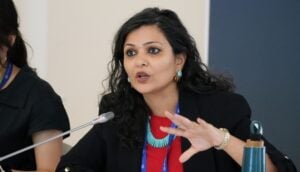Today, new economic powers have emerged, private investment to developing countries has soared, and new technologies have opened opportunities as never before. The nature of development is changing, with collaboration across diverse stakeholders now a central feature of the development landscape. In particular, partnerships with the private sector are playing an increasingly important role.
New opportunities for partnership, along with an ambitious sustainable development agenda enshrined in the Global Goals, leave us no longer asking whether we should partner, but rather how we can use partnership most effectively. USAID has a long history of partnering, and we are constantly seeking to evolve our approach to partnerships to respond to the changing development landscape. We’d point to three critical themes which we believe are critical to the next generation of partnerships in global development.
From Shared Interest to Shared Value
Big global challenges—from food security to climate change—affect businesses as well as communities, yet cannot be addressed by any single player. It is in all of our interests to address these challenges together. We’ve seen a tremendous increase in partnerships between the private sector and the development community, partnerships that leverage the resources and capabilities of public, private, and nonprofit sector players to tackle a challenge where there are aligned interests. More than addressing shared interest however, shared value recognizes the business opportunity in addressing social problems, and the ability to generate business value while also achieving social impact.
With developing economies now a key markets for growth, and consumers demanding greater corporate accountability and social responsibility, a growing number of the world’s leading corporations are proactively pursuing shared value opportunities in order to drive growth and profitability while delivering impact for the communities and countries where they operate.
To help ensure we are finding these opportunities, USAID has created a number of tools that allow for co-creation with the private sector, and unlock local and international financing. The Global Development Alliance—USAID’s flagship model for public-private partnerships—and Development Credit Authority guarantees—which incentivize private lenders to extend financing to underserved populations—allow us to partner broadly with the business sector to achieve shared goals that not only generate economic but also societal value.
Evidence from our partnerships globally has demonstrated that partnerships are the most effective when they have deep links between business strategies and development objectives. In Nigeria, for example, USAID partnered with Olam, an agricultural trading and distribution company, to enable the company to source rice from Nigerian smallholders for the first time. This partnership leveraged USAID’s expertise in working with smallholders and Olam’s buying power to increase farmer income and productivity, and spur the development of the Nigerian rice sector.
We have seen that true partnerships with common objectives that share risks and rewards create more collaborative, effective, and impactful solutions to global problems. We believe the private sector is a valuable partner in addressing industry-wide and systems level issues in areas such as environmental sustainability, education and workforce development, and governance and transparency.
Tackling Systems Change
We are also seeing a shift in how organizations are coming together to tackle development issues, with a desire to go beyond one-off partnerships to addressing a problem in a more enduring and wide-reaching way. To meet the Global Goals, it’s clear that the next generation of partnerships will need to address systems-level change.
These challenges often require collective action to bring stakeholders together around a common agenda, goals, and measures of success to harness the collective strength of diverse actors not only at the scale of an individual project, but at the scale of the complex systems in which development challenges are embedded.
Our private sector partners are ready for these challenges. A UN Global Compact Survey of over 1,000 global CEOs from 103 countries found that 78 percent believe companies should engage in industry collaborations and multi-stakeholder partnerships to address sustainability and development goals.
Multi-stakeholder initiatives (MSIs) are one approach that development agencies like USAID are using to tackle complex problems. We’ve seen success through models like Power Africa, a large multi-stakeholder alliance that brings together the strengths and resources of African governments, private sector investors and 12 U.S. government agencies to generate cleaner, more efficient electricity and increase energy access across the continent. Since its launch in 2013, Power Africa’s private sector partners have committed more than $31 billion, and its development partners have committed over $12 billion in support of the alliance’s goals and targets.
However, in practice, MSIs can be the most complex and difficult to design, manage, and implement. Along with Omidyar Network, USAID supported a first of its kind study by the Global Development Incubator (GDI), “More than the Sum of Its Parts: Making Multi–Stakeholder Initiative…” focused on understanding the lessons learned from the creation of multi-stakeholder initiatives for development over the past two decades, in order to provide practical guidance to those in the development sector seeking to mobilize alliances that tackle systems-level issues.
Looking ahead, we need to continue to develop ways to increase the impact and reduce the transaction costs of multi-stakeholder models—for instance, by promoting governance models that encourage streamlined decision making and operating and funding models that enable multiple capabilities and funding sources to be combined effectively.
Rise of Local Actors
Finally, it is critical that the global development community more fully recognizes and leverages the unique and significant value that local private sector actors bring to partnerships. As developing economies become increasingly sophisticated, dynamic, and globally oriented, so too have many local private sector actors.
While many of USAID’s high-profile partnerships are with multi-national companies, USAID has numerous partnerships with national and local businesses. In 2015 alone, USAID had more than 430 active public-private partnerships, 55 percent of which involved local actors. In some regions, USAID’s largest private sector partners were local actors.
A recent USAID study examined USAID’s portfolio of partnerships with local actors, and identified the distinctive sources of value that local companies, financial institutions, business associations, and NGOs and civil society actors can bring to partnerships which advance development objectives. We found local partners’ unique capabilities—such as their access to local networks, deep local knowledge, and commitment to the local market—are serving as important contributors to ensuring local ownership and the longevity of development efforts.
For example, in Tumaco, Colombia—a region that has long been a center for the illegal production of coca and violent crime—USAID is working with local, family-owned chocolate company Casa Luker to support and raise incomes for thousands of local farmers through a community-owned cacao cooperative that provides an alternative to coca production. Since its launch in 2014, the cooperative has raised the price for cacao farmers across the region, and improved the incomes of more than 3,000 farmers. This story and others are featured in USAID’s newly launched report on local private sector partnerships.
Global trends are beginning to “crowd in” the local private sector into the development arena. Engaging these local partners will be increasingly important as we work collectively to achieve sustainable development results.
Leveraging Innovation
Throughout Global Partnerships Week, which launches today, we will hear how a number of our partners are leveraging innovative ideas, tools and approaches to further development efforts, including partnerships which harness the power of media to effect positive behavior change on gender issues; and collaborations that use technology to mobilize people and partners like never before.
In order to achieve USAID’s mission of ending extreme poverty and the bold vision of the Global Goals, we need continued leadership in leveraging partnerships as a means to address complex problems. And at USAID, we are grateful to our thousands of partners—global and local, corporate and start-up—who are working to achieve this shared vision. We look forward to collaborating with partners old and new to build the next generation of partnerships for development.
This article first appeared on www.p3.co and is reproduced with permission.










3 Responses
It would be difficult to disagree with much in this article. Partnership helps organisations to concentrate on the bits that they are best placed to deliver while collaborating to gain access to resources from other providers for mutual benefit. What is not to like about this?
The biggest challenge for smaller, entrepreneurial and dare I say it often more innovative organisations from outside the establishment is breaking in. Whilst private sector start-ups recognise both the value of marketing to amplify their great propositions and the need to fund it, this is much harder for not-for-profits, where the proportion of funding going directly to beneficiaries is often a key metric.
Thoughts from the community on how best to open the doors to new innovation would be greatly appreciated.
I agree with the above comment and highlight the point raised by Mark regarding NGOs.
Large scale initiatives such as Power Africa are worthy projects. These projects often do not address the small NGOs and local development associations that struggle in accessing funding and or effective partnerships.
A partnership that involves a collaborative and consultative approach with all stakeholders is more likely to achieve sustainable results.
Thanks for sharing your thoughts, Chris. I love the examples you included. It is important to share success stories in order to rally others behind the effort.